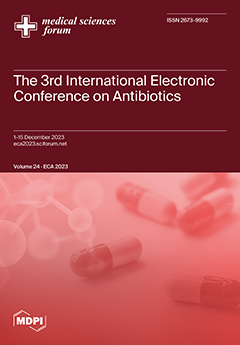Background: Staphylococcus aureus, particularly methicillin-resistant
S. aureus (MRSA), has emerged as a leading antimicrobial-resistant pathogen challenging global health systems and antibiotic therapy. Pigs have been identified as important reservoirs for livestock-associated MRSA. The major concern with MRSA occurrence in pigs is
[...] Read more.
Background: Staphylococcus aureus, particularly methicillin-resistant
S. aureus (MRSA), has emerged as a leading antimicrobial-resistant pathogen challenging global health systems and antibiotic therapy. Pigs have been identified as important reservoirs for livestock-associated MRSA. The major concern with MRSA occurrence in pigs is the potential for human transmission. Reports on the prevalence and antibiotic sensitivity pattern of methicillin-susceptible
S. aureus (MSSA) and MRSA strains in pigs in Nigeria are still limited, hence, the need for this study. This study was designed to investigate the prevalence of MRSA and methicillin-sensitive
Staphylococcus aureus in pig farms in Ibadan, Oyo State, Nigeria, and to determine their antibiotic resistance patterns.
Methods: We collected 93 composites (n = 5; total n = 465) of faecal samples from pigs in twenty-five farms across five local government areas in Ibadan, Nigeria. Isolation of
S. aureus was conducted using standard procedures. Antibiotic sensitivity testing was conducted using the disc diffusion method. The data obtained were analysed using descriptive statistics and compared with the CLSI and EUCAST standards for sensitivity and resistance.
Results: The prevalence of
S. aureus was 31.2%, with the proportion of MSSA and MRSA isolates being 23.7% and 7.5%, respectively. The antibiotic susceptibility profiles revealed a high multidrug resistance prevalence among both MSSA (86.4%) and MRSA (100%). All MRSA isolates and 40.9% (9/22) of MSSA were found to be resistant to at least five different sub-classes of antibiotics.
Conclusions: This study supports the existing reports on pigs being an important reservoir of highly resistant
S. aureus strains. The high multidrug resistance and the occurrence of MRSA may be evidence of continuous antimicrobial exposure and substandard hygienic practices on these farms. This is undesirable because it constitutes a health hazard for farmers, veterinarians, abattoir workers, and pork consumers, who may further disseminate these highly resistant strains to their families and society. There is a need for further surveillance and a multisectoral approach involving policymakers, farmers, health practitioners, and the public in implementing good infection control practices and safe antibiotic usage from the grassroots level on farms in line with the vision of the one health approach.
Full article



